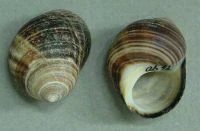
Periwinkles
Name Variations[]
- winkle
- Littorina littorea
About Periwinkles[]
Periwinkles, scientifically known as Littorina scutulata, are little aquatic gastropods which can be found in groups all along rocky shores in the intertidal zones. Periwinkles dimensions vary from two and half millimeters to fifty millimeters and approximately fifty grams. Periwinkles are mobile and they survive by feeding themselves with algae. Periwinkles have thick walled, turban-shaped shells, with a fairly simple operculum. There are two types of periwinkles: flat periwinkles and black periwinkles. Flat periwinkles have wide, pointed shells with three spirals in its spire, light grayish to brown shells. This shell is frequently irregular or eroded and it appears like it is decomposing. Black periwinkles look rather different then other periwinkles. Black periwinkle’s shell is flat, black and thin and has the form of a cone, but is smaller than flat periwinkles shell and it has four spirals instead of three. Periwinkles eat by using their randula which helps them scrap e algae from the rocks. Periwinkle shell’s colors vary from bright yellow to black. Black periwinkles and dark colored periwinkles are often confused with small rocks.
There are over 300 species of this conical, spiral-shelled Univalve Mollusk, but few are edible. Periwinkles, also called bigaros, sea snails or winkles, are found attached to rocks, wharves, pilings, etc. in both fresh and sea water. The most common edible periwinkle is found along the Atlantic coasts of Europe and North America. It grows to about 1 inch in size and is gray to dark olive with reddish-brown bands. Periwinkles are popular in Europe but rarely found in the United States. They're usually boiled in their shells, then extracted with a small pick.
